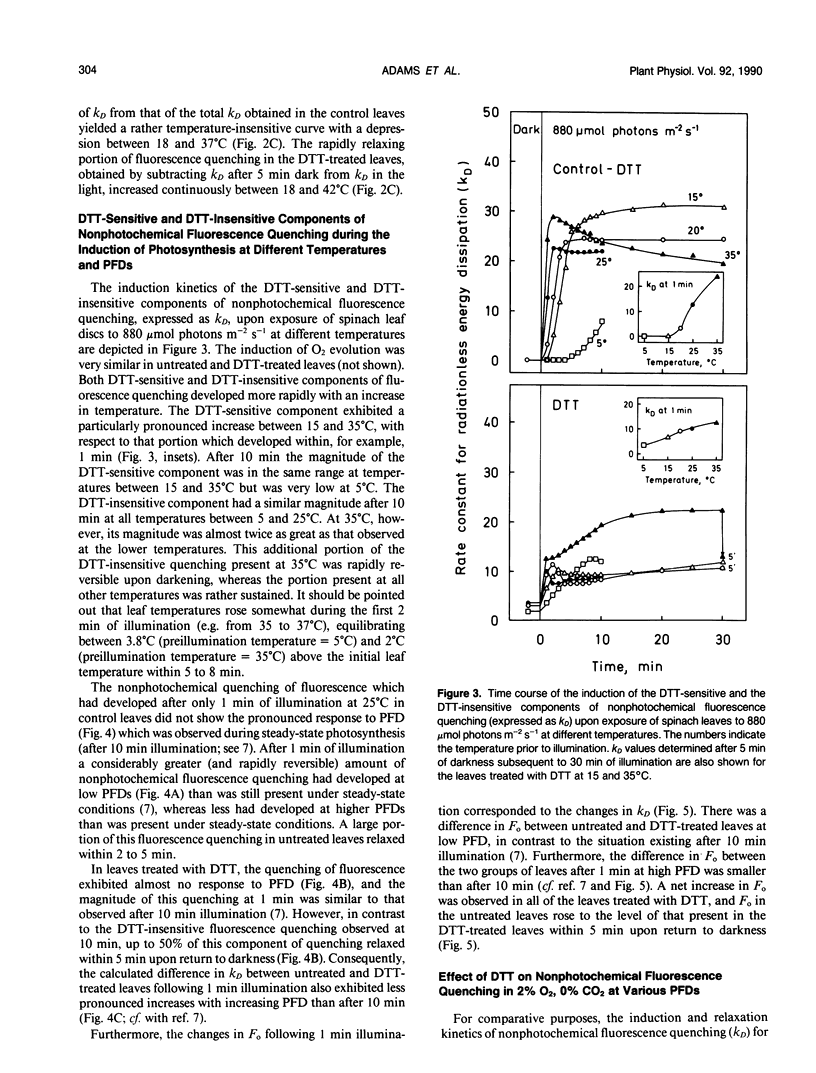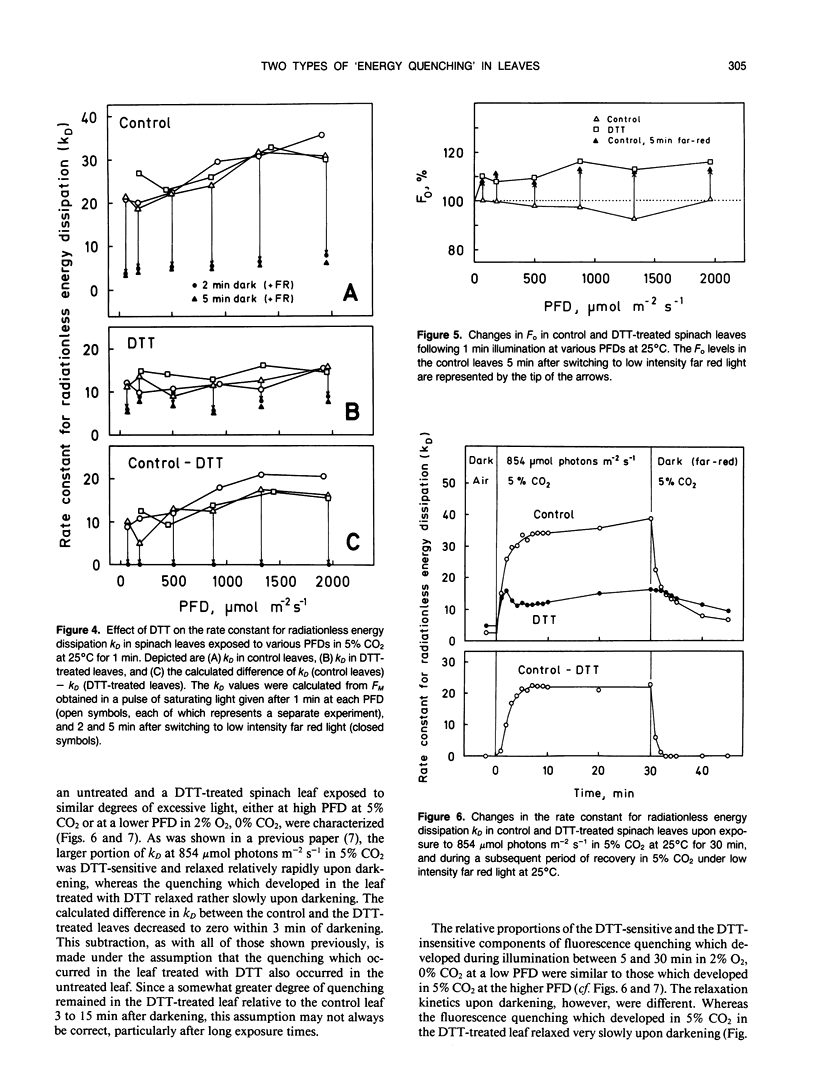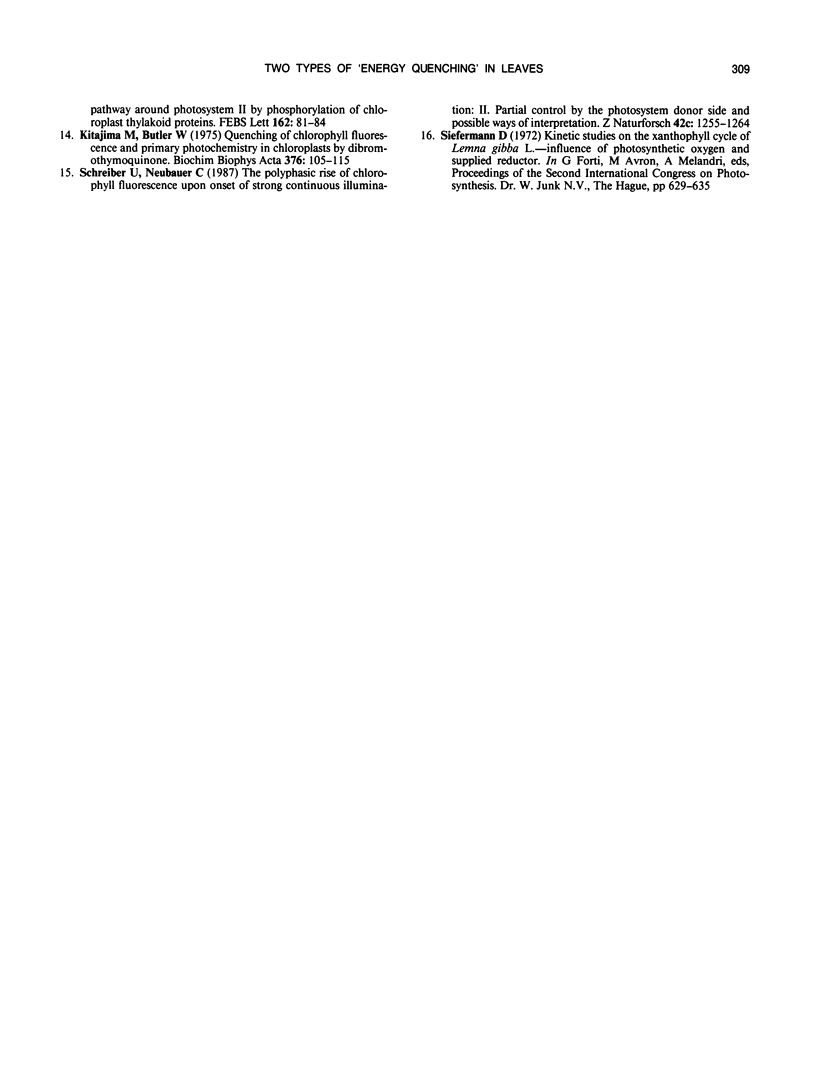Abstract
We have identified two rapidly relaxing components of non-photochemical fluorescence quenching which suggests that dissipative processes occur in two different sites in the photochemical system of leaves. Under a variety of treatment conditions involving different leaf temperatures, photon flux densities (PFD), exposure times, and in the presence of 5% CO2 or 2% O2, no CO2, the components of nonphotochemical fluorescence quenching were characterized with respect to their sensitivity to dithiothreitol (DTT, which completely inhibits zeaxanthin formation), the effect on instantaneous fluorescence, and the rapidity of relaxation upon darkening. Under most circumstances the DTT-sensitive component (associated with a quenching of instantaneous fluorescence and correlated with zeaxanthin) represented the majority of the rapidly relaxing portion of fluorescence quenching. A DTT-insensitive (zeaxanthin-independent) component, which also relaxed rapidly upon darkening but was not associated with a quenching of instantaneous fluorescence, became proportionally greater in an atmosphere of 2% O2 and no CO2, at elevated leaf temperatures, and to some degree during the induction of photosynthesis (1 minute after the onset of illumination). A third component which was also DTT-insensitive and was sustained upon darkening, was largely suppressed in 2% O2, O% CO2. We conclude that, under conditions favorable for photosynthesis, energy dissipation occurred mainly in the chlorophyll antennae whereas, under conditions less favorable for photosynthesis, a second dissipation process, probably in or around the reaction center of photosystem II, also developed. Furthermore, evidence is presented that the zeaxanthin-associated dissipation process prevents sustained inactivation of photochemistry by excessive light.
Full text
PDF







Selected References
These references are in PubMed. This may not be the complete list of references from this article.
- Bilger W., Björkman O., Thayer S. S. Light-induced spectral absorbance changes in relation to photosynthesis and the epoxidation state of xanthophyll cycle components in cotton leaves. Plant Physiol. 1989 Oct;91(2):542–551. doi: 10.1104/pp.91.2.542. [DOI] [PMC free article] [PubMed] [Google Scholar]
- Butler W. L., Kitajima M. Fluorescence quenching in photosystem II of chloroplasts. Biochim Biophys Acta. 1975 Jan 31;376(1):116–125. doi: 10.1016/0005-2728(75)90210-8. [DOI] [PubMed] [Google Scholar]
- Demmig-Adams B., Adams W. W., Heber U., Neimanis S., Winter K., Krüger A., Czygan F. C., Bilger W., Björkman O. Inhibition of zeaxanthin formation and of rapid changes in radiationless energy dissipation by dithiothreitol in spinach leaves and chloroplasts. Plant Physiol. 1990 Feb;92(2):293–301. doi: 10.1104/pp.92.2.293. [DOI] [PMC free article] [PubMed] [Google Scholar]
- Demmig-Adams B., Winter K., Krüger A., Czygan F. C. Light Response of CO(2) Assimilation, Dissipation of Excess Excitation Energy, and Zeaxanthin Content of Sun and Shade Leaves. Plant Physiol. 1989 Jul;90(3):881–886. doi: 10.1104/pp.90.3.881. [DOI] [PMC free article] [PubMed] [Google Scholar]
- Demmig-Adams B., Winter K., Krüger A., Czygan F. C. Zeaxanthin Synthesis, Energy Dissipation, and Photoprotection of Photosystem II at Chilling Temperatures. Plant Physiol. 1989 Jul;90(3):894–898. doi: 10.1104/pp.90.3.894. [DOI] [PMC free article] [PubMed] [Google Scholar]
- Demmig-Adams B., Winter K., Krüger A., Czygan F. C. Zeaxanthin and the Induction and Relaxation Kinetics of the Dissipation of Excess Excitation Energy in Leaves in 2% O(2), 0% CO(2). Plant Physiol. 1989 Jul;90(3):887–893. doi: 10.1104/pp.90.3.887. [DOI] [PMC free article] [PubMed] [Google Scholar]
- Demmig B., Winter K., Krüger A., Czygan F. C. Photoinhibition and zeaxanthin formation in intact leaves : a possible role of the xanthophyll cycle in the dissipation of excess light energy. Plant Physiol. 1987 Jun;84(2):218–224. doi: 10.1104/pp.84.2.218. [DOI] [PMC free article] [PubMed] [Google Scholar]
- Kitajima M., Butler W. L. Quenching of chlorophyll fluorescence and primary photochemistry in chloroplasts by dibromothymoquinone. Biochim Biophys Acta. 1975 Jan 31;376(1):105–115. doi: 10.1016/0005-2728(75)90209-1. [DOI] [PubMed] [Google Scholar]


